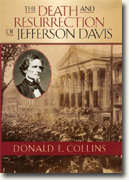Donald E. Collins
book reviews:
· general fiction
· chick lit/romance
· sci-fi/fantasy
· graphic novels
· nonfiction
· audio books
· author interviews
· children's books @
curledupkids.com
· DVD reviews @
curledupdvd.com
newsletter
win books
buy online
links
home
for authors
& publishers
for reviewers

 |
The Death and Resurrection of Jefferson Davis Donald E. Collins Rowman & Littlefield Hardcover 216 pages May 2005 |
|
Jefferson Davis was the only President of the Confederate States of America, and more popular after the Civil War and his death than he was during the Civil War. He joined Robert E. Lee and Stonewall Jackson as the most popular Confederates, according to author Donald Collins. He never asked for nor received a presidential pardon for his part in the Civil War, and he was imprisoned at Ft. Monroe, Virginia, for two years. He was kept in chains and allowed neither visitors nor any privacy.
Davis tried his best to run the country and win the war for independence. The South lost the War because it eventually became outnumbered and could not provide its military like the North could with new soldiers, weapons, food, and other materials. Many faulted Davis for this loss since he was the president. After his imprisonment, he returned to his home in Mississippi; in 1886 and 1887 he was asked to help with dedications of monuments in various cities in the South. Collins’ book is mainly about Davis’ return to fame after his imprisonment. During his tours of 1886 and 1887, it was discovered that Davis was very popular with the Southern Whites as the symbol of the Lost Cause and the one who suffered imprisonment for the South. He was in his 70s when he did these tours and they exhausted him, but he and others knew he was popular again. In 1889, Davis died in New Orleans while on a business trip. Many Southern cities wanted the honor to be the site of his burial. His funeral was huge with many dignitaries from the South in attendance. Davis’ second wife, Varina, was not up to deciding where to bury him permanently, so it was decided to temporarily bury him in a tomb in New Orleans. His body stayed there for three and half years until it was finally decided and arranged for him to be reburied in Richmond, Virginia, the former Confederate capital. The trip from New Orleans to Richmond was a big event, just like his tours had been. The train carrying his casket and other dignitaries had to stop at some towns and cities where people would line up to view his casket. At towns where the train did not stop, people would gather anyway to get a glimpse of his casket in its glassed-in car. At capital cities, his casket would lie in state for a few hours for people to pay their respects to him, and thousands did indeed pay tribute to him as the symbol of the Lost Cause. After his burial in Richmond people began the task of organizing and raising money to construct a monument to him. The monument took a long time to come about due to lack of funds and disorganization, but in 1907 a monument was finally dedicated to him. Donald Collins is an associate professor of history emeritus at East Carolina University. He has written several books and articles on the Civil War. This is an interesting book to read about how Jefferson Davis became a symbol of the Lost Cause and of the Confederacy. There are many quotes, bibliographical references, notes, interesting illustrations and an index in this book. Collins clarifies that Davis was not captured wearing a dress, as some Northern propagandist had said. He says, “Davis’ wife threw a shawl over his head and he threw a raglan over his shoulders to avoid detection” (p. 17). This book belongs in any Civil War collection. © 2005 by Br. Benet Exton, O.S.B. for curledup.com. |
|
|
|
 Click here to learn more about this month's sponsor! |
|
| fiction · sf/f · comic books · nonfiction · audio newsletter · free book contest · buy books online review index · links · · authors & publishers reviewers |
|
| site by ELBO Computing Resources, Inc. | |
 Jefferson Davis had been U.S. Secretary of War and a U.S. senator. He was also a hero of the Mexican War. His first wife was the daughter of President Zachary Taylor; he himself was a famous politician in the national government. When Abraham Lincoln and the Republicans came to power in 1860, they were known for wanting to end slavery. Davis and other Southerners decided it was time for the South to leave the Union. Davis was one of the representatives from Mississippi at the Provisional Confederate Congress that met in Montgomery, Alabama. There he was elected the president and the capital was moved to Richmond, Virginia.
Jefferson Davis had been U.S. Secretary of War and a U.S. senator. He was also a hero of the Mexican War. His first wife was the daughter of President Zachary Taylor; he himself was a famous politician in the national government. When Abraham Lincoln and the Republicans came to power in 1860, they were known for wanting to end slavery. Davis and other Southerners decided it was time for the South to leave the Union. Davis was one of the representatives from Mississippi at the Provisional Confederate Congress that met in Montgomery, Alabama. There he was elected the president and the capital was moved to Richmond, Virginia.